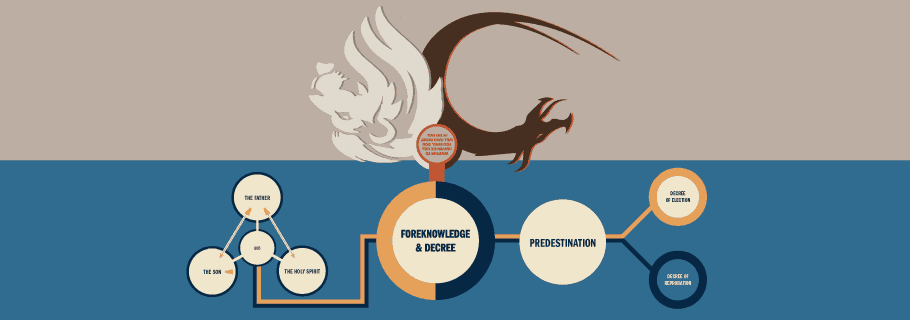We recently produced two “new” visual theology posters that are really not new at all. Both were updates of posters created by Puritan authors John Bunyan and William Perkins. Here is Bunyan’s and here is Perkins’. Both of these men had attempted to provide a means of visual instruction showing how God saves his people (and damns those who are not his people). Both were evaluated by Sinclair Ferguson in his excellent book The Whole Christ. I thought you might find it interesting to consider the posters in light of Ferguson’s analysis.
The subtle nature of the issue pointed up here emerges in a rather puzzling difference between two works produced at opposite ends of the Puritan era. Both William Perkins (1558–1602) and John Bunyan (1628–1688) produced what Perkins described as an “ocular catechism”—in his case a diagram of “The Golden Chaine of Salvation” and in Bunyan’s “A Map Shewing the Order and Causes of Salvation and Damnation.”
Both “charts” appear to have the same goal—to give a pictorial representation of how God works in relation to salvation and damnation. They are single-page, visual representations of truths that would take an entire volume to expound; their diagrammatic form made them helpful for those with poor reading skills and perhaps even for some with none. In essence they were Puritan PowerPoint presentations!
The same elements are present in each chart as they trace salvation from eternity to eternity. There is, however, one major, striking, albeit puzzling, difference.
In Perkins’s chart, every aspect of the application of salvation is tied in to a central spine representing Christ in terms of the various clauses of the Apostles’ Creed. One might surmise that Calvin’s words quoted earlier had made a profound impact on him.
In Bunyan’s chart, however, the Father, the Son, and the Holy Spirit are portrayed as the fountainhead of salvation. Everything flows from them. But Bunyan’s map has no Christ-spine. Certainly the Trinity is seen as the original source and cause of salvation. But the various aspects of salvation applied are related to each other, not directly to Christ. To use Perkins’s metaphor, it is as if the links in the chain are joined one to another but are remotely connected to Christ himself only as their original link and first cause.
It would doubtless require a doctoral dissertation to explore all the issues involved in these differences and to what extent they were played out in the preaching of the gospel. But to whatever extent this impacted Bunyan’s preaching, these charts represent two different configurations of how the gospel works. In the case of Perkins’s Golden Chaine the central significance of Christ and union with him is obvious; in Bunyan’s chart this is not so. In Perkins every spiritual blessing is related to Christ; benefits are never separated or abstracted from the Benefactor. In Bunyan’s map, in fact they are.
If this mode of thinking permeates our approach to gospel preaching, the focus inevitably shifts to abstracted and discrete blessings, and then to the question of how we receive them, and thus ultimately to the issue: “Under or through what conditions can these blessings become mine?” The tendency is to turn me inward. But the warrant for justifying faith in Christ does not lie within. To think this was precisely the mistake of the young Luther. For this reason Staupitz’s famous instruction to seek his predestination “in the wounds of Christ” was a telling exhortation that would lead him to discover that the warrant for the gospel is without, not within.
Slowly this way of thinking about the ordo salutis may drift into what is sometimes referred to as “the steps of salvation” in which a quasi-chronological order of experience precedes actual faith. This can become an eerie echo of the medieval ordo salutis. In due course, since these steps follow one another, the completion of one step must precede the commencement of the next one. And precisely there the question arises, How much conviction of sin, or sorrow for sin, or turning away from sin is required before the next step or phase can begin?










